Video conf. 29 Nov. 2015 - Biodiversity Strategy & Mapping
SWIFFT video conference notes are a summary of the video conference and not intended to be a definitive record of presentations made and issues discussed.
This video conference was supported through resources and technology provided by the Department of Environment, Land, Water and Planning, Victoria. SWIFFT wishes to thank speakers for their time and delivery of presentations.
The fourth and final video conference for 2015 had a theme on Victoria's Biodiversity Strategy and Biodiversity Mapping technologies.
A total of 94 participants were connected across 16 locations; Ararat, Ballarat, Bairnsdale, Benalla, Bendigo, Colac, Geelong, Hamilton, Heywood, Horsham, Heidelberg (Arthur Rylah Institute), Melbourne (Nicholson Street), Mildura, Orbost, Traralgon and Warrnambool.
List of groups/organisations in attendance;
Educational: Federation University, Gordon TAFE
Local Government: Yarra Ranges Shire, Manningham City, Colac Otway Shire, Moorabool Shire, Baw Baw Shire, Macedon Ranges Shire.
Field Naturalist Clubs: Ballarat, Geelong, Hamilton, Portland.
Community Conservation Groups: Geelong Environment Council, Ballarat Environment Network, Victorian Volcanic Plains Biosphere Network, Bellarine Landcare, Wattle Flat/Pootilla Landcare, Napoleons Landcare, Torquay Landcare, Wombat Forestcare.
Conservation Organisations: Helen Macpherson Smith Trust, Port Phillip Westernport CMA, Trust for Nature, Birdlife Australia, Western Coastal Board, Wimmera CMA, Corangamite CMA, Goulburn Broken CMA, Parks Victoria, Bellarine Bayside Committee of Management, Department of Economic Development, Jobs, Transport and Resources (DEDJTR), Parks Victoria, Vic Forests, Department of Environment, Land, Water and Planning (DEWLP) staff across 15 locations, inc. Nicholson Street Melbourne and Arthur Rylah Institute, Heidelberg,
Industry: VicRoads.
KEY POINTS SUMMARY Quick take home messages from this video conference or read through the speaker summaries.
SPEAKER SUMMARIES
Developing Victoria's Biodiversity Strategy (October 2015) - Adam Muir, Manager of Biodiversity Strategy, Department of Environment, Land, Water & Planning
Note: Information presented in relation to this topic is relevant at 29 November 2015 and may change as the strategy is further developed.
Biodiversity Strategy context
Adam introduced his presentation providing by background to the process which stems from an election commitment from Government 'Our Environment Our Future'.
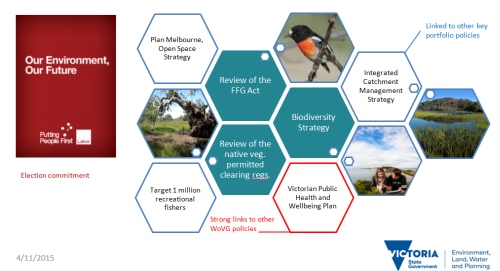
'Our Environment Our Future' also includes a review of the Flora and Fauna Guarantee Act 1988, the Native Vegetation Clearing Regulations and other environment related matters e.g. Victorian Public Health and Wellbeing Plan which makes the connection between environment and health.
The new strategy will build on previous work where relevant (e.g. Land and Biodiversity White Paper, draft Biodiversity is Everyone's Business and draft Threatened Species Strategy).
Overview of the project
Adam emphasised the need to mainstream biodiversity.
Purpose of the Strategy
The strategy needs to create the case for “biodiversity” that places it in the mainstream for Victoria and identifies the most important steps for everyone to take so we have a healthy world to live in.
Scope
The strategy will cover marine, terrestrial and freshwater environments.
Length
Adam said the team is aiming for a short but high level overarching strategy (e.g. 30 pages) which contrasts to the Land and Biodiversity White Paper which contained many actions. The approach will be to have a higher level strategy which could accompanied by action plans / implementation type plans and a strategy that is applicable for many years.
Timing
Consultation of a Draft Strategy is expected in early 2016 with the Final Strategy mid 2016.
Engagement
Adam spoke about the rapid timelines for the project i.e. 12 months from start to finish. This has meant a detailed and targeted process involving a number of reference groups which will be followed up with broader consultation upon the release of a draft.
Environment Portfolio Reference Group
To foster a sense of ownership amongst key environmental portfolio agencies of the strategy (and its implementation) and the FFG Act review.
- CMAs x 2
- DELWP staff (including regions)
- Melbourne Water
- Museum Victoria Parks Victoria
- Royal Botanic Gardens
- Trust for Nature
- Victorian Coastal Council
- Zoos Victoria
Stakeholder Reference Group
To bring together key stakeholder groups for a series of facilitated meetings to test key themes relevant to the biodiversity strategy and FFG Act review.
- BirdLife Australia
- Bush Heritage Australia Victoria National Park Association
- Environmental Farmers Network
- Environment Justice Australia
- Environment Victoria
- Federation of Victorian Traditional Owner Corporations
- Landcare x 2
- Local government x 3
- Municipal Association of Victoria
- NAB
- Scientist (ecological expert)
- The Nature Conservancy
- Victorian Farmers Federation
Private Land Working Group
To provide a more focussed consideration of the important role of private land conservation to inform the draft biodiversity strategy (Hosted by Trust for Nature).
- Bush Heritage Australia
- DELWP
- Greening Australia
- The Nature Conservancy
- Trust for Nature
- Victoria National Park Association
Science Reference Group
To test key scientific concepts relevant to the biodiversity strategy and advise on the most important places where science can input to implementation. Adam thought the role of this reference group would continue for some time.
The Science Reference Group Comprises 10 Victorian scientists from a range of agencies and research institutions who together have expertise in the fields of:
- flora, fauna and ecology
- ecological processes
- conservation planning and decision making
- measurement and monitoring
- genetics.
Why is biodiversity important ?
Adam spoke about the following points emphasising that Victoria's future prosperity and liveability is dependent on maintaining and restoring natural capital which includes biodiversity.
-
Victoria’s unique biodiversity and nature is part of our identity. For thousands of generations Aboriginal communities have cared for the environment. A healthy environment also remains central to Victoria’s contemporary values and aspirations for the future.
-
Victorians not only value nature for its intrinsic value, we recognise that our environment underpins a high standard of living for Victorians e.g. recreational opportunities such as fishing, nature based tourism.
-
Our environmental assets are our natural capital which provides us with essential services - clean air, clear water and fresh food and fibre. Like any capital asset we need to maintain the condition of that asset otherwise it will fail.
-
Victoria’s natural environment is dynamic, in restoring our natural capital to deliver benefits to Victorians, we need to work with change. A healthy environment has the capacity to respond to shocks by adapting e.g. to climate change or fires.
-
Nature is not only vital for life, its pivotal to the Victorian way of life. A healthy natural environment supports much of what makes Melbourne one of the world’s most liveable cities, and regional Victoria a great place to live.
Issues facing biodiversity
Adam spoke about Victoria being the most cleared state in Australia and the on-going loss of our natural capital which is estimated to be around ~4000 habitat ha/yr. Climate change, loss of habitat, weeds, pests, changes in fire and water regimes being contributing factors impacting on species both now and into the future.
Directions in the new strategy
Adam said it is important to reverse the trend in biodiversity decline and undertake a process of restoration across landscapes. It is also important that people connect with the natural environment and want to protect it.
There is also a need to ensure biodiversity is valued and considered in decision making.
Updates on the process
To register for Biodiversity Strategy updates - e-mail
Biodiversity Portal
Adam provided a brief overview of the new biodiversity portal being developed by DELWP that will replace the Biodiversity Interactive Map. The aim is to have data sets more available to view along with tools that support consistent decision-making to guide investment and management.
The Portal will appear mid-2016 on the internet and will improve over time through frequent updates.
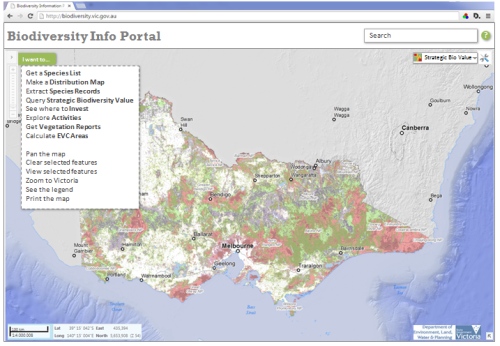
The new portal will be uncluttered. It will contain a layer list, tools and an 'l want to' menu.
Key points from questions
There is a large gap between the number of records collected by the community and the capacity to validate and enter records onto the Victorian Biodiversity Atlas.
Progress is being made to ensure records submitted to the Biodiversity Atlas will be processed by the next working day and viewed with caveat until fully verified.
It was suggested the strategy could recognise that all the ecosystems which existed prior to European settlement have a right to exist, not just for human benefit. This is reflected in the intrinsic value of biodiversity.
The biodiversity strategy will be a high level document that will set out priorities and decision making and will sit several tiers above many existing strategies.
The process of actions / implementation of the new strategy has not been fully decided upon yet. Actions could be contained in the plan or through accompanied documents . When the draft strategy is released there will be a number of supporting technical documents including work from the Strategic Developments Prospects.
A number of important principles including the precautionary principle will be included in the strategy to assist future implementation over the next 10-15 years.
Fire ecology will be included in the strategy.
Biodiversity education will be included in the strategy, at this stage there are ongoing considerations about the drivers and most effective pathways.
Including biodiversity education in outdoor education programs from early childhood through school years could be looked at as a valuable means of connecting young people with nature.
The biodiversity strategy will have no impact on the biodiversity strategies for the Melbourne growth corridors.
Development of the biodiversity strategy will include consideration of existing regulatory measures.
There are many existing publications relating to biodiversity that could be made available to the education sector.
Visualising Victoria's Biodiversity - Rob Milne, Research Associate, Centre for eResearch and Digital Innovation, Federation University - Australia.
Rob provided a brief overview of the Centre for eResearch and Digital Innovation at Mt Helen which comprises about 30 staff (12 research, 8 technical, 7 project, 3 administration). He said the aim is to contribute to and enhance technology application and knowledge transfer to a whole range of fields of interest. This is done through Research Domains and Technology Services leading to Research Outputs with real world applications. More information regarding CeRDI projects.
Examples of projects that use technology which is applicable to Visualising Victoria's Biodiversity
Visualising Victoria's Groundwater - this project brings research domain expertise (in this case groundwater and hydrogeology) mixing that with new technologies to deliver a web based product enabling visualisation of statewide groundwater resources on-line.
Soil health knowledge base - gathering hundreds of layers of all the known information on soil health across the Corangamite CMA and bring it together in a product that can be easily visualised.
Natural Resource Management Portal - development of web base mapping to match local and regional priorities for catchment by empowering Landcare networks, community groups and stakeholders to map projects and local knowledge.
Rob said technologies used in the development of these types of projects can be applied to other areas such as Visualising Victoria's Biodiversity (VVB). See FedUni Spatial showcases for more examples.
CeRDI role in SWIFFT
Rob spoke about the role of CeRDI in transiting the old SWIFFT wiki to a new State Wide model whilst continuing to run SWIFFT under a collaborative framework and introduce new technologies such as the VVB which is being supported by the Helen Macpherson Smith Trust. This work involves:
- Establish data sharing agreements and collaboration with key data custodians
- Upgrade swifft.net.au website
- Develop VVB map portal
- Support on-going content creation and management on the web site.
CeRDI is also very interested in undertaking Impact assessment research to measure how new technologies make a difference and delivering what people need.
How SWIFFT works
Rob spoke about how the different components of SWIFFT work together around the community and stakeholders to deliver citizen science. SWIFFT also feeds into spatial layers and shares data from spatial layers.
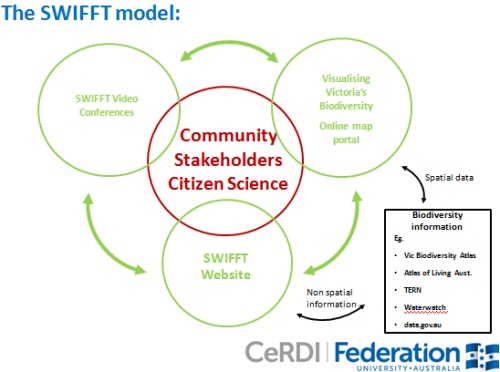
Core principles
• Multi sector collaboration (community, government, education/research, NGOs).
• Strong community and citizen science focus through website and mapping.
• Apolitical.
• Free and open access.
• Acknowledges and values community expertise and knowledge.
• Knowledge and data sharing is good for conserving and improving biodiversity.
• Easy and useful.
SWIFFT is a collaboration between a range of stakeholders – not owned/run by one group
Visualising Victoria's Biodiversity
The VVB is being developed to be a GIS web based mapping portal. As the technology becomes more advanced it enables more information to be included in the system. CeRDI is a strong supporter of open data standards which enables the sharing of information and data generated from the project to other systems.
Examples of what the VVB can display
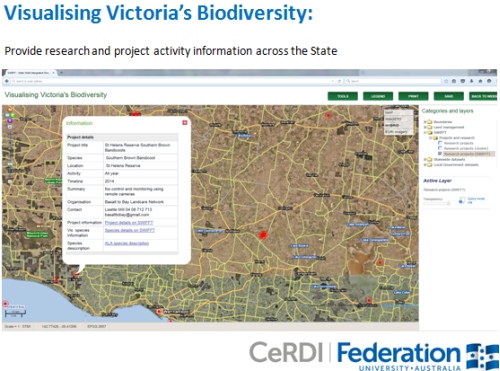
Research and project activity - information across the State which can be displayed with links to additional resources, e.g. Atlas of Living Australia or project specific sites.
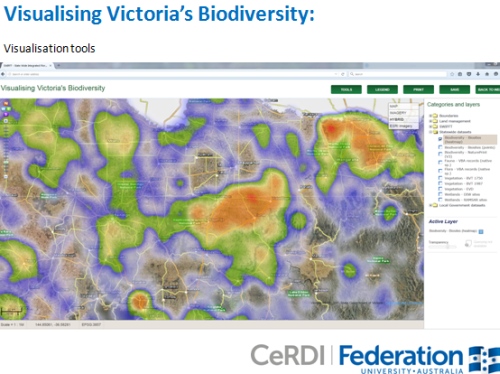
Visualisation tools - these can be used to analyse layers of data to show trends and visualisation of information.
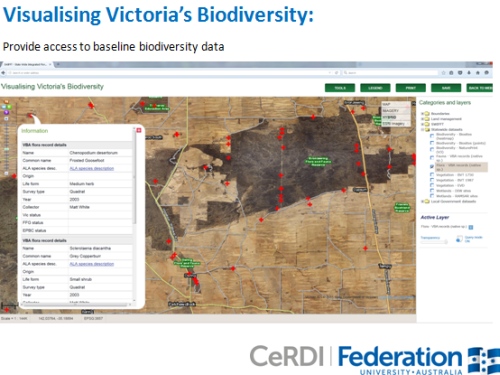
Viewing base line biodiversity data - the sharing of data has become more open in recent years which enables new technologies to access and work with data in new ways. The VVB can be linked dynamically with Biodiversity Atlas data managed by DELWP.
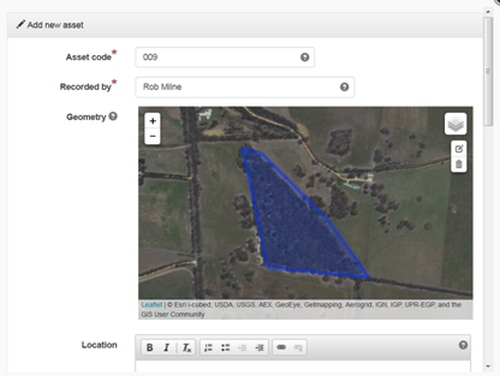
Citizen science - the VVB will enable users to map their own projects enabling greater and more visual knowledge sharing.
Help build SWIFFT
Rob spoke about the need for people to contribute their views to the process.
- Contribute via SWIFFT on-line survey
- There will also be workshops in the near futur.e
- Feedback channels will be included on the website and VVB.
Key points from questions
CeRDI is very open to collaboration with other Universities, particularly as the project becomes more established.
There are tremendous opportunities for sharing information to and from DELWP and using the SWIFFT as a means of providing easily viewable information. Collaboration and establishing data share agreements are important aspects.
An important challenge for SWIFFT's development is to ensure it is meeting the needs of the community.
There are opportunities to build improved ways for Field Naturalist Clubs to contribute information to SWIFFT. This will be factored into project development.
At present the Victorian Biodiversity Atlas can accept spreadsheets but the process can be difficult so the easiest way is to e-mail the VBA
It is important to consider surveys that reveal the absence of species which were once in an area. This type of information can be valuable in understanding changes to ecosystems.
A strength of SWIFFT is the ability to personalise project information, survey results and observations.
Inclusion of burn history would be a valuable layer in the VVB.
There needs to be a process for managing Citizen Science information by assigning various levels of reliability making it clear to the user the source and validity of data.
KEY POINTS SUMMARY
| The Biodiversity Strategy needs to mainstream “biodiversity” for Victoria and identify the most important steps for everyone to take so we have a healthy world to live in. |
| The Biodiversity Strategy will be a short but high level overarching strategy which could be accompanied by action plans / implementation type plans and a strategy that is applicable for the next 10-15 years. |
| Consultation of a Draft should occur in early 2016 with the Final Strategy mid 2016. |
| DELWP is developing a new Biodiversity Portal that will replace the Biodiversity Interactive Map by mid 2016. |
| Visualising Victoria's Biodiversity is being developed by CeRDI to be a GIS web based mapping portal that will form part of SWIFFT's Citizen Science objectives. |
| The development of technologies used in other CeRDI projects can be applied to Visualising Victoria's Biodiversity (VVB). |
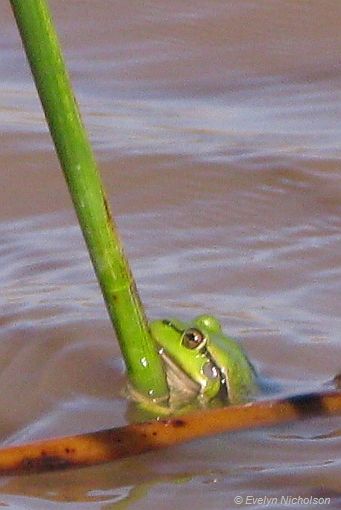 |
| Growling Grass Frog - endangered |
- Register for Biodiversity Strategy updates – e-mail
- View FedUni Spatial showcases
- Contribute to the SWIFFT on-line survey


